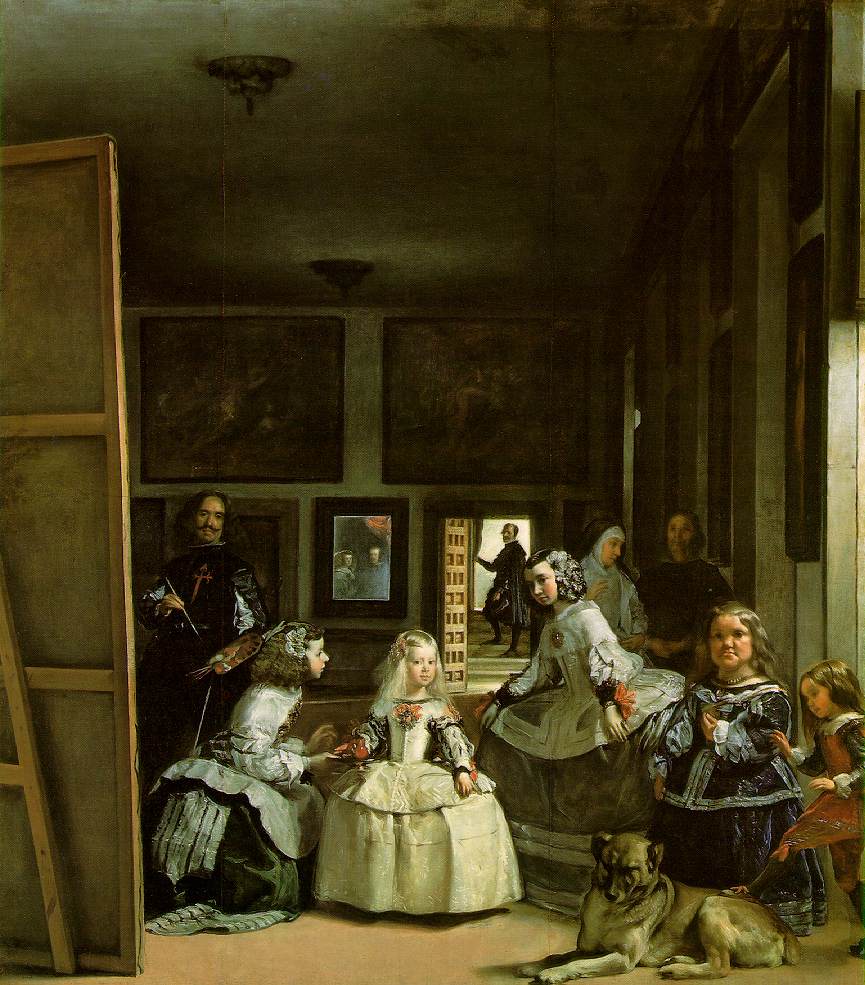 A few weeks ago, the Google main page had an excerpt from Velázquez's Las Meninas above the search bar, which was remarked upon at Yossarian Lives. If Google felt inspired by the great painting, how would it have engaged others? A cursory search for Las Meninas - on Google - elicited numerous references. That search sufficed to create this post.
A few weeks ago, the Google main page had an excerpt from Velázquez's Las Meninas above the search bar, which was remarked upon at Yossarian Lives. If Google felt inspired by the great painting, how would it have engaged others? A cursory search for Las Meninas - on Google - elicited numerous references. That search sufficed to create this post.
Andrew Graham-Dixon in his superlative series on the Art of Spain described Las Meninas in panegyric terms. Everything in the painting, he said is about transience. The fabrics, the textures, the skin, the hair, the dwarfs, everything is hovering on the brink of disappearance. Some of the figures are so light that if they moved, the scene would disperse, the moment would pass. No matter how powerful one is, the experience is in the end transitory... Spanish power, Spanish might, Spanish glory, it's all come down to these figures. They will pass, they will die. Everything will come to an end.
 Others, more optimistic, found the work exalting. Picasso, for instance, studied it acutely, producing forty-four interpretations of it during a brilliant burst of creative output in 1957. His intention was to absorb the qualities of Velázquez's art and demonstrate that he was fully equal to the master, both in execution and in inspiration. In his characteristic cubist style, and in continuation of his study of other greats such as Delacroix and El Greco, he engaged in a dialogue with Velázquez, exploring the survival of the motifs in Las Meninas. In his painting of the Infanta, shown here to the right, he aimed to show the dislocation of her posture - eyes towards her parents, but with her body oriented towards the dwarf. He wanted, in short, to accentuate the dual nature of the little girl's gaze.
Others, more optimistic, found the work exalting. Picasso, for instance, studied it acutely, producing forty-four interpretations of it during a brilliant burst of creative output in 1957. His intention was to absorb the qualities of Velázquez's art and demonstrate that he was fully equal to the master, both in execution and in inspiration. In his characteristic cubist style, and in continuation of his study of other greats such as Delacroix and El Greco, he engaged in a dialogue with Velázquez, exploring the survival of the motifs in Las Meninas. In his painting of the Infanta, shown here to the right, he aimed to show the dislocation of her posture - eyes towards her parents, but with her body oriented towards the dwarf. He wanted, in short, to accentuate the dual nature of the little girl's gaze.
Picasso explained 1 to Jaume Sabartés:
If anyone were to copy Las Meninas in complete good faith, and for example got to a certain point - and if I were the copier - would say to myself, and if I just put this a little more to the right or to the left? I would try to do it in my own way, forgetting about Velázquez.
 Picasso's compatriot, Salvador Dalí,was similarly driven to absorb the picture on various levels. Unlike other Surrealists who disdained the Old Masters, Dalí believed there was much to learn from the works of his predecessors. In one homage, Portrait of Juan de Pareja, shown to the left here, he depicts the
Picasso's compatriot, Salvador Dalí,was similarly driven to absorb the picture on various levels. Unlike other Surrealists who disdained the Old Masters, Dalí believed there was much to learn from the works of his predecessors. In one homage, Portrait of Juan de Pareja, shown to the left here, he depicts the 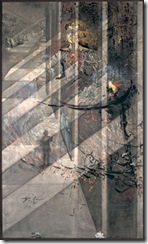 court official from Las Meninas standing at the doorway. Elusive is the profile of de Pareja in the centre of the painting, his moustache and beard forming from the grouping of the Spanish Infanta and her attendants. In other homages, Dalí shows off the colour palette that he attributed to Velázquez, as for instance, this pseudo-holographic vision of the Infanta from 1958. Here he distorts the proportions of the composition to make her bigger and, unlike Picasso, makes the figure of the artist smaller and depicts him from behind at work on a canvas that in its turn represents the Infanta. 2
court official from Las Meninas standing at the doorway. Elusive is the profile of de Pareja in the centre of the painting, his moustache and beard forming from the grouping of the Spanish Infanta and her attendants. In other homages, Dalí shows off the colour palette that he attributed to Velázquez, as for instance, this pseudo-holographic vision of the Infanta from 1958. Here he distorts the proportions of the composition to make her bigger and, unlike Picasso, makes the figure of the artist smaller and depicts him from behind at work on a canvas that in its turn represents the Infanta. 2
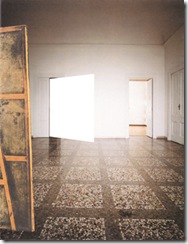 In Italy, it is traditional to invite an author after a successful premiere of a play onto the stage with the cry Fuori l'autore! The enigmatic Giulio Paolini plays a pun on this cry with the eponymously titled collage on photograph, seen here. As in Las Meninas, there is a room, an easel, a doorway, but there is also emptiness. The author has vanished as has the mirror that originally reflected the viewers, the Royals. Do we get a sense of the infinite through the open door?
In Italy, it is traditional to invite an author after a successful premiere of a play onto the stage with the cry Fuori l'autore! The enigmatic Giulio Paolini plays a pun on this cry with the eponymously titled collage on photograph, seen here. As in Las Meninas, there is a room, an easel, a doorway, but there is also emptiness. The author has vanished as has the mirror that originally reflected the viewers, the Royals. Do we get a sense of the infinite through the open door?
More recently, the German artist Iz Maglow attempted his own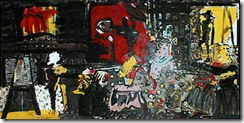 elucidation of the sudden moment of suspense thrown into the midst of an otherwise cosy familial scene. When the chamberlain opens the door at the far end of the room, he breaks into a situation of warmth; his advent foreshadows doubt. What will happen next?
elucidation of the sudden moment of suspense thrown into the midst of an otherwise cosy familial scene. When the chamberlain opens the door at the far end of the room, he breaks into a situation of warmth; his advent foreshadows doubt. What will happen next?
If so many artists have borrowed and added to Las Meninas, why not collect their works in one place for the edification of the masses? At the Museu Picasso in Barcelona, running till September 2008, is a remarkable exhibition with exactly this idea in mind. Placed in juxtaposition to the master's work, the artists attempt to interpret from every conceivable angle what Velázquez intended.
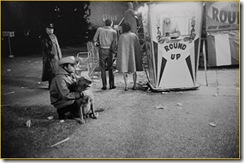 But it is not only painters who have taken Velázquez's masterpiece to heart. Paolini, above, offers photographic tribute. The even more enigmatic Garry Winogrand has produced a superb work of allusion, very reminiscent of the multiple perspectives of Velázquez. Winogrand's subjects in this photograph (from the book Winogrand 64, page 259) have been frozen at moment in time from which - in true Everett-style - multiverses spin off. A couple looks at something outside the frame and the policeman looks at a man who is staring to the right, again at something off-camera. In the words of Juan Oliver et al:
But it is not only painters who have taken Velázquez's masterpiece to heart. Paolini, above, offers photographic tribute. The even more enigmatic Garry Winogrand has produced a superb work of allusion, very reminiscent of the multiple perspectives of Velázquez. Winogrand's subjects in this photograph (from the book Winogrand 64, page 259) have been frozen at moment in time from which - in true Everett-style - multiverses spin off. A couple looks at something outside the frame and the policeman looks at a man who is staring to the right, again at something off-camera. In the words of Juan Oliver et al:
We don’t know if there is a connection between these characters, or what are they looking at and why. We can intuit seeds of future actions in this photograph, but we cannot be sure about them. Something is happening behind the scene and at the right, and the characters of the photograph are looking to these events. The behaviour or relations between the characters could change due to those events, but we have only one shot. We cannot know for sure if this image shows an equilibrium or not, and we remain intrigued.
 Sculpture cannot be far behind the graphic arts, can it? Indeed it cannot. And so we have Manolo Valdés, who likes to quote from well-known artworks and lend them a different grace by placing them in new contexts. In 2007, his series of statues of the Infanta appeared on Esplanadi, in Helsinki, and was met with such rapturous attention that it became a travelling exhibition, getting displayed in Las Ramblas, Dusseldorf, Beijing, Madrid...
Sculpture cannot be far behind the graphic arts, can it? Indeed it cannot. And so we have Manolo Valdés, who likes to quote from well-known artworks and lend them a different grace by placing them in new contexts. In 2007, his series of statues of the Infanta appeared on Esplanadi, in Helsinki, and was met with such rapturous attention that it became a travelling exhibition, getting displayed in Las Ramblas, Dusseldorf, Beijing, Madrid...
Despite having turned my back on computer science and its allied engineering fields, I must confess that I am constantly amazed by the developments in that field. Eleven years ago, computer 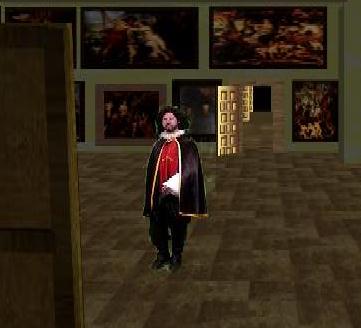 graphics already were of rather high standard, and Hisham Bizri and his colleagues at the University of Illinois at Chicago put the latest technologies to work in their creation of a virtual reality representation of Las Meninas. It begins with an empty room, the room where Diego Velázquez will create his masterpiece. The virtual representation (accompanied by a Bach clavier piece) is now embellished with the figures that form the painting. And here comes the trick rendered by the graphics: the viewer, originally constrained into the painter's field of view, now can wander around, and investigate the aspects of the art from manifold perspectives. What does the chamberlain Nieto at the far end see as he enters the room? If Velázquez were to look out the window on his left, what sights would appear before him? What was once the preserve of imagination has now become the domain of the visual.
graphics already were of rather high standard, and Hisham Bizri and his colleagues at the University of Illinois at Chicago put the latest technologies to work in their creation of a virtual reality representation of Las Meninas. It begins with an empty room, the room where Diego Velázquez will create his masterpiece. The virtual representation (accompanied by a Bach clavier piece) is now embellished with the figures that form the painting. And here comes the trick rendered by the graphics: the viewer, originally constrained into the painter's field of view, now can wander around, and investigate the aspects of the art from manifold perspectives. What does the chamberlain Nieto at the far end see as he enters the room? If Velázquez were to look out the window on his left, what sights would appear before him? What was once the preserve of imagination has now become the domain of the visual.
Computer animation has made great leaps in synthesizing reality, but old-fashioned film is still truer to life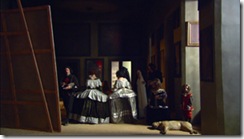 . Eve Sussman produced and directed a video titled 89 Seconds at Alcázar, in which actors in the roles of the protagonists of Las Meninas assemble into the exact configuration of the painting. (Surely there is something to be said for a final product that is less than a minute-and-a-half long, but which was three years in the realisation!) Velázquez, by placing the King and the Queen of Spain in the position of the viewers of the artwork, essentially extended the visual space into real life. Sussman, similarly, wanted to extend the painting as the culmination of a sequence of events that were in themselves quite pedestrian.
. Eve Sussman produced and directed a video titled 89 Seconds at Alcázar, in which actors in the roles of the protagonists of Las Meninas assemble into the exact configuration of the painting. (Surely there is something to be said for a final product that is less than a minute-and-a-half long, but which was three years in the realisation!) Velázquez, by placing the King and the Queen of Spain in the position of the viewers of the artwork, essentially extended the visual space into real life. Sussman, similarly, wanted to extend the painting as the culmination of a sequence of events that were in themselves quite pedestrian.
My piece ... [treats] it as the seminal cinema verité film still. The piece ultimately looks baroque but was inspired by the opposite - an interest in the everyday. Restaging the situation leading up to the moment depicted in the painting, 89 Seconds presents an imagined unfolding of minute movements that could have framed the scene. By linking the singular scene of the painting with a continuity of events I attempted to script and choreograph body language, instead of simply observing it in everyday life.
References
1. Museu Picasso, Announcement of New Exhibition: Forgetting Velazquez, 2008.
2. Museu Picasso, Forgetting Velázquez: Las Meninas. Exhibition. 2008.
3. Salvador Dali, Portrait of Juan de Pareja, the Assistant to Velázquez

4 comments:
Thank ye. Finally, all Las Meninas references / homages that one knows of (and the ones one doesn't) in one place!
Excellent article!
Nameste!
Veena: Danke. Did you check out the museum link? Even more lovely stuff there that I didn't reference. Did you see this exhibit during your Barcelona trip?
Labsji: thanks, man. Pranam to you as well!
Feanor: Yep, awesome stuff alright. And no, I think the special exhibit wasn't on display when we were there.
On Picasso, did you hear about the special exhibit in Reina Sofia his year in Madrid? Sounds interesting.
Post a Comment